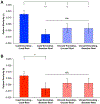Hippocampal signatures of awake targeted memory reactivation
- PMID: 30478610
- PMCID: PMC6420837
- DOI: 10.1007/s00429-018-1790-2
Hippocampal signatures of awake targeted memory reactivation
Abstract
Dominant theories of episodic memory propose that a key mechanism of memory consolidation is replay-a process, whereby neural patterns of activation during learning are reinstated during offline post-learning periods. Here, we tested whether key signatures of replay defined by studies in rodents, such as recapitulation of specific memory traces, as well as sequences, are apparent in humans during post-encoding memory reactivation. Thirty participants underwent functional imaging that consisted of interleaved encoding and rest periods. During an offline period of wakeful rest, we biased reactivation towards some memories by presenting sound cues that had previously been associated with particular stimulus sequences. Results showed that targeted hippocampal reactivation was biased towards cued memory sequences and that reactivation signatures preserved the temporal order of particular sequences. Importantly, the biased reactivation was related to differences in subsequent memory, suggesting that preferential reactivation may be a mechanism by which specific memory traces can be strengthened for enhanced subsequent memory retrieval.
Keywords: Hippocampus; Memory consolidation; Memory reactivation; Representational similarity analysis.
Conflict of interest statement
Conflict of Interest
The authors declare that they have no conflict of interest.
Figures






References
MeSH terms
Grants and funding
LinkOut - more resources
Full Text Sources

